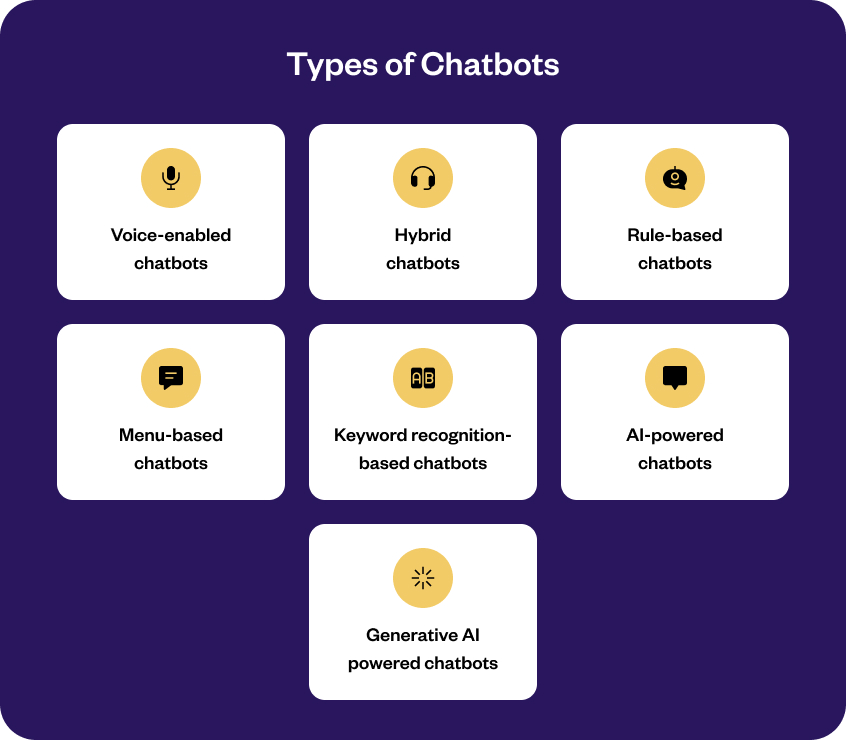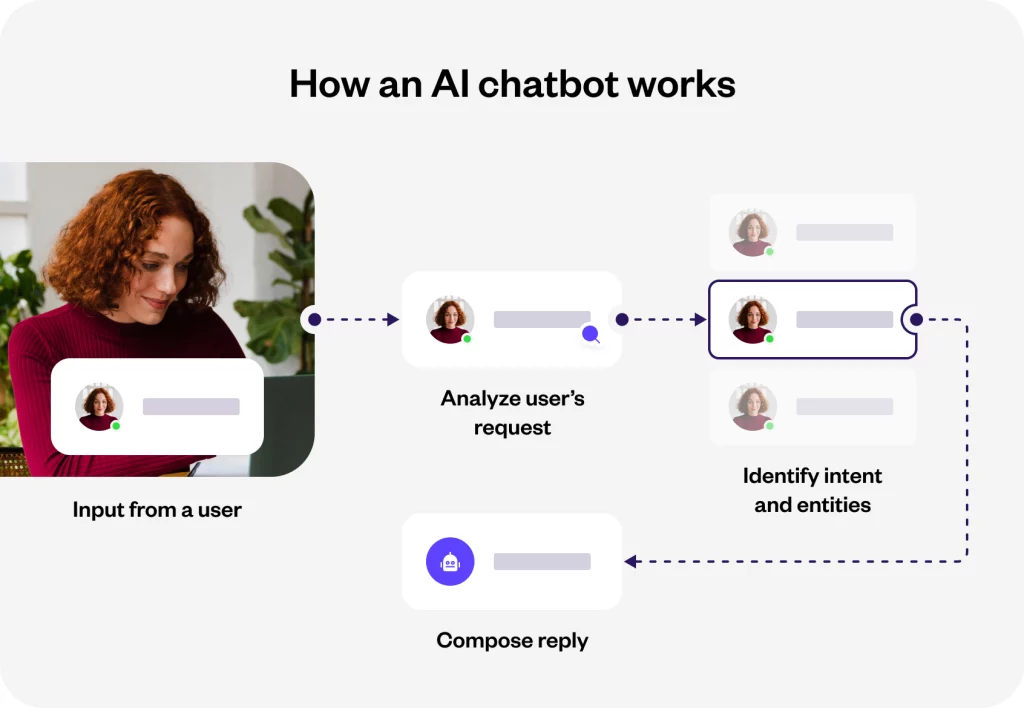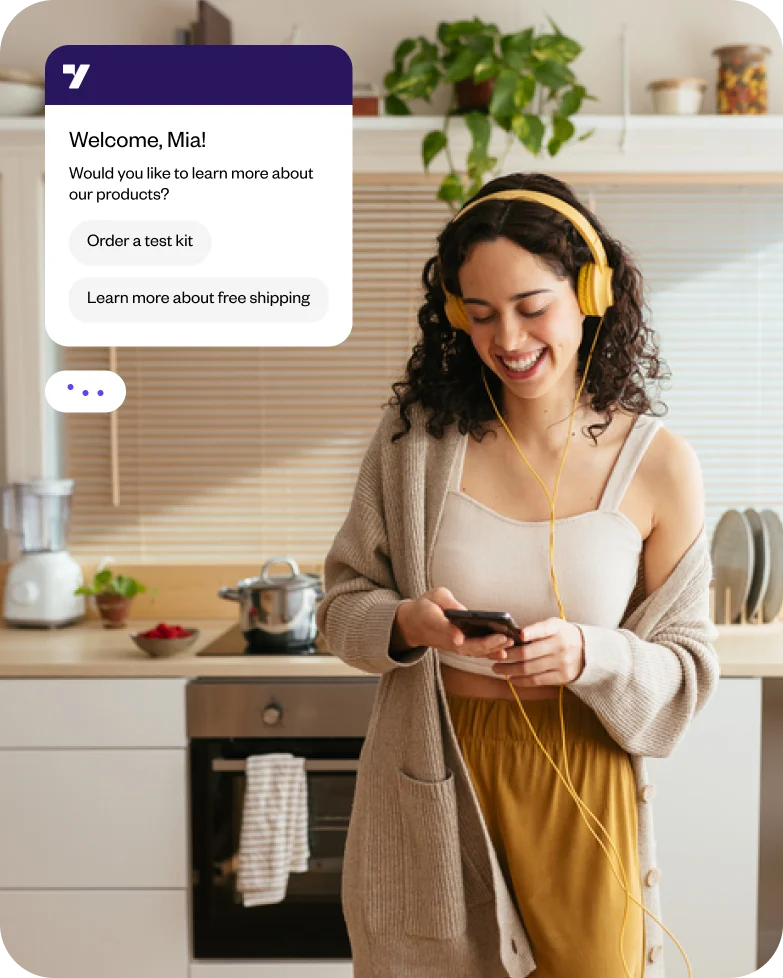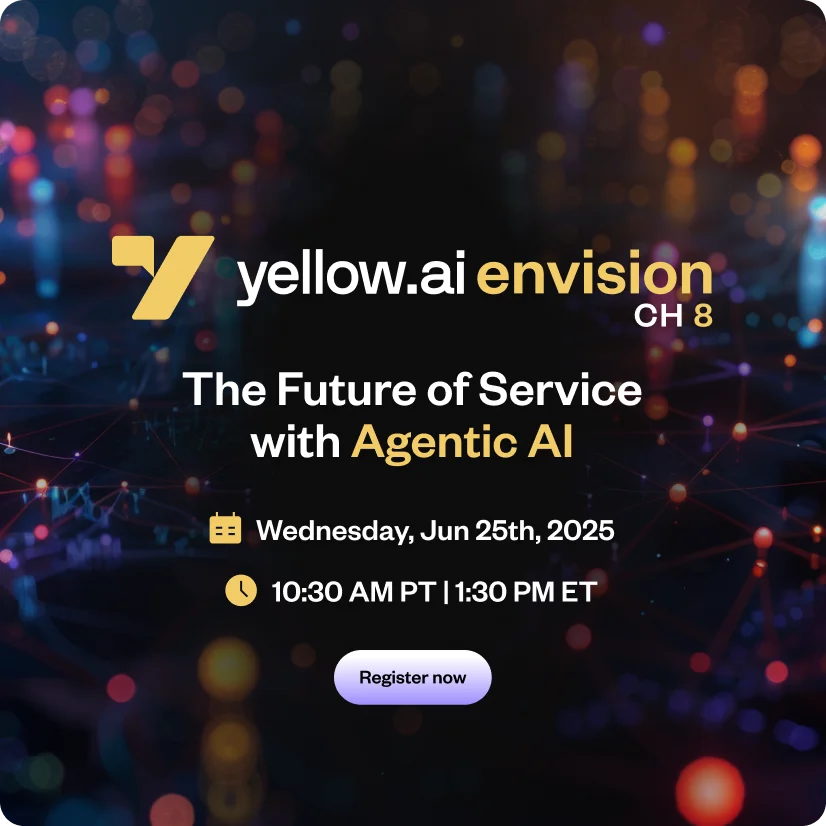Executive summary
In 2024, AI chatbots will stand at the forefront of technological innovation in business communication. This article delves into the realm of AI chatbots, exploring their definition, types, and the various ways they enhance customer engagement and operational efficiency. Focusing on the latest advancements and the best AI chatbots of the year, we provide a detailed overview of how these digital assistants are transforming the customer journey map and managing workflows, all while highlighting key players like Yellow.ai in simplifying AI chatbot creation.
The year 2024 marks a turning point in how businesses interact and connect. At the heart of this transformation are AI chatbots, transcending traditional text-based dialogues to deliver rich, context-sensitive, and personalized user experiences. Their widespread adoption across diverse industries signifies a significant shift in customer relations and operational methodologies. The chatbot market, mirroring this trend, is expected to see explosive growth, with projections indicating a 22.5% increase from 2020 to 2027, reaching an astounding $1,953.3 million in value. Such growth underscores the chatbots’ vital role across various industries, signifying a significant shift in customer relations and operational methodologies.
Imagine a journey from humble digital beginnings to sophisticated, multi-faceted tools that not only respond to queries but also predict needs, analyze complex data, and even influence decision-making. This is the story of AI chatbots, driven by leaps in AI, natural language processing, and machine learning. These advancements have endowed chatbots with an ability to learn and evolve from each interaction, ensuring they not only converse but connect on a more human level.
As we go deeper into the world of AI chatbot in 2024, we’ll explore how they are revolutionizing the way businesses engage with their customers and optimize their internal processes. The impact of AI chatbots is far-reaching, setting new benchmarks in efficiency and transforming the customer journey into an immersive, interactive experience.
Related must-reads:
- Enterprise chatbot – Types, benefits and examples
- Top 17 benefits of chatbots for businesses and customers
- 9 Real life chatbot examples [well-known brands]
- Chatbot design – How to design a successful chatbot?
- 30 Chatbot applications from six key industries
- Future of Chatbots: Key Trends to Watch in 2023!
What is an AI chatbot?
In digital communication, AI chatbots are the game-changers for businesses in 2024. An AI chatbot is a sophisticated blend of technologies that simulates human-like conversation through text or speech interfaces. These aren’t your average chatbots that simply follow a script; AI chatbots are imbued with artificial intelligence, machine learning (ML), and natural language processing (NLP). They have the extraordinary ability to understand, interpret, and respond to user queries in a manner that mirrors human interaction.
For businesses, this translates into a more dynamic way of engaging with customers. Instead of offering generic replies, AI chatbots can navigate complex conversations, making customers feel heard and understood. They are a practical solution for today’s businesses, helping to streamline customer interactions, gather insights, and improve overall service efficiency. As we move through 2024, these chatbots are becoming indispensable in the toolkit of modern businesses, reshaping the landscape of digital customer service.
Types of chatbots
The world of chatbots presents a diverse array of options, each designed to cater to specific business needs and customer interaction styles. Understanding these types is crucial for businesses to choose the right type of chatbot that aligns with their objectives and customer engagement strategies. Here’s a rundown of the key types of chatbots available:
Related read: 6 Types of chatbots – How to choose the best for your business?

Each type of chatbot has its unique strengths and ideal use cases. For businesses in 2024, understanding these types helps in selecting the right chatbot that not only meets their current needs but also aligns with their future growth and customer engagement strategies.
Which is better: Rule-based chatbot or AI chatbot?
Digital communication is ever-evolving, and businesses often grapple with the decision between rule-based and AI chatbots. Each type has its unique strengths and applications, making the choice largely dependent on the specific needs and goals of a business.
Rule-based chatbots operate on predefined rules and logic. They can handle specific, predictable queries where responses can be pre-scripted. The significant advantage of rule-based chatbots lies in their simplicity and reliability. They are easier to set up and control, ensuring consistent responses to common queries. It makes them ideal for businesses looking for a straightforward, cost-effective solution for handling routine customer interactions.
AI chatbots, on the other hand, are powered by artificial intelligence, particularly machine learning and natural language processing. It allows them to understand and interpret a wide range of customer queries, providing more dynamic and contextually relevant responses. AI chatbots excel in handling complex interactions, learning from past conversations, and improving over time. They are well-suited for businesses aiming for a more advanced, interactive customer experience, capable of handling nuanced and varied customer needs.
The choice between rule-based and AI chatbots hinges on the complexity of the interactions a business anticipates with its customers. For straightforward, predictable tasks, rule-based chatbots are efficient and cost-effective. However, for a more engaging, personalized customer experience that evolves with user interactions, AI chatbots are the superior choice.
Comparison: Rule-based chatbots vs. AI chatbots vs Next-gen AI bots
| Comparison | Rule-based chatbots | AI chatbots | Next-gen AI bots |
|---|---|---|---|
| Technology Used | Predefined rules | NLP, ML, AI algorithms | Advanced NLP, LLMs, generative models |
| Learning Capability | No learning | Basic learning based on limited training data sets | Continuous learning, self improvement and adaptation based on large data sets |
| Complexity Handling | Limited complexity | Moderate-to-high complexity | High complexity and open-ended conversations |
| Adaptability | Limited adaptability. Limited to disparate channels. | Can adapt to user inputs across channels. | Highly adaptive to user context across channels |
| Understanding | Keyword-based matching | Improved understanding of user intent | Enhanced contextual understanding |
| Personalization | Limited personalization. | Intermediate level of personalization | Highly personalized responses at scale |
| Advanced Features | None | Multilingual, multimodal interaction | Multilingual, emotional intelligence, creativity |
| Use Cases | Basic FAQs, simple tasks. Not conversational | Conversational. End-to-end customer support, e-commerce, virtual assistants | Advanced customer engagement, dynamic Interactions, creative conversations, end-to-end customer support, e-commerce, virtual assistants |
Businesses must assess their specific requirements, customer interaction complexity, and resource availability to make the right choice between these two powerful digital tools.
Benefits of AI chatbots: Amplifying business potential
AI chatbots have moved past mere efficiency enhancers to pivotal tools in crafting meaningful customer experiences. These advanced digital assistants offer a range of benefits that extend beyond cost savings, tapping into deeper layers of customer engagement and operational effectiveness.
Let’s understand the key benefits of AI chatbots and explore how they are redefining customer interactions.
- 24/7 Customer service availability
- Handling high-volume queries
- Empowering agents with valuable insights
- Seamless integration with business ecosystems
- Personalized customer experiences
- Cost-effective customer engagement
- Proactive customer engagement
1. 24/7 Customer service availability
AI chatbots transcend the boundaries of time, providing round-the-clock service to customers across the globe. This perpetual availability ensures that customer queries are addressed instantly, regardless of the hour, enhancing customer satisfaction and loyalty.
Example
A customer from a different time zone visits your e-commerce website. It’s after-hours for your support team, but the AI chatbot is there, ready to help. The customer has questions about product customization options, which the chatbot addresses effortlessly, even suggesting complementary products. This round-the-clock assistance turns a casual browse into a confirmed purchase, demonstrating the chatbot’s ability to drive conversions outside traditional business hours.
Related must-reads:
- What Is Customer Service and How Can You Improve It?
- Conversational AI for Customer Service
- Customer experience vs customer service: More than just semantics
- Customer service chatbots: Benefits and examples [2023]
- How to improve customer service?
2. Handling high-volume queries
The business environment today is fast-paced, and AI chatbots are adept at managing a high volume of customer interactions simultaneously. This ability significantly reduces wait times and improves overall efficiency, allowing human agents to focus on more complex issues.
Example
During a seasonal sale, your retail website is inundated with inquiries. The AI chatbot efficiently categorizes and responds to these queries, from stock checks to delivery times, preventing the potential loss of sales due to overwhelmed human agents. This scalability ensures a smooth customer experience, even under high demand.
3. Empowering agents with valuable insights
AI chatbots are beyond just conversation handlers; they are insightful data gatherers. By analyzing customer interactions, they provide valuable insights to human agents, enhancing the quality of customer service and aiding in strategic decision-making.
Example
In a scenario where a customer has a complex billing issue, the AI chatbot initially engages and collects preliminary information. Once it identifies the complexity, it seamlessly transfers the query to a human agent, who now has all the necessary information to resolve the issue quickly. This synergy between AI and human intelligence leads to more efficient problem-solving and higher customer satisfaction.
4. Seamless integration with business ecosystems
AI chatbots in 2024 are adept at integrating seamlessly with various business systems like CRM, inventory management, and marketing platforms. This integration streamlines workflows and ensures a cohesive customer journey.
Example
small business owner wants to deploy an AI chatbot but lacks technical expertise. Using Yellow.ai, they quickly create a chatbot tailored to their business needs, which not only handles customer inquiries but also integrates with their CRM system for seamless data management. This hassle-free deployment with Yellow.ai enables even small businesses to compete in the digital space effectively.
5. Personalized customer experiences
One of the most significant advantages of AI chatbots is their ability to personalize interactions. By analyzing past interactions and customer data, chatbots can tailor conversations, making each interaction unique and relevant to the individual customer.
Example
A returning customer interacts with your AI chatbot, which recognizes their purchase history and preferences. It suggests new products aligned with their taste and even remembers their size preferences, making the shopping experience feel highly personalized and thoughtful. This level of personalization cultivates a sense of brand loyalty and increases the likelihood of repeat purchases.
Related must-reads:
- Conversational AI for Customer Experience?
- Customer experience in retail: Strategies and the future of CX
- How to improve customer experience? Full guide
- AI and automation in customer experience
- How to improve customer service experience?
6. Cost-effective customer engagement
Deploying AI chatbots is a cost-effective solution for businesses. By automating routine interactions, they reduce the need for extensive human customer service teams, leading to significant savings in operational costs.
Example
A first-time visitor on your site is browsing but seems hesitant. The AI chatbot initiates a conversation, offering assistance. Based on the visitor’s browsing behavior, the chatbot suggests a beginner’s guide to your product range and a first-time purchase discount. This proactive engagement converts a hesitant browser into a confident buyer.
7. Proactive customer engagement
AI chatbots in 2024 are not just reactive; they are proactive in engaging customers. They can initiate conversations based on customer behavior or events, enhancing engagement and customer retention.
Example
An AI chatbot, observing a customer’s repeated visits to a product page, initiates a conversation offering detailed information about the product and a special one-time discount, encouraging the customer to make a purchase.
Related must-reads:
- Customer engagement in the digital age – What to expect?
- How to Increase Customer Engagement?
- AI chatbots for customer engagement
Understanding how AI chatbots work: A deep dive into their mechanics
At their core, AI chatbots are a blend of various technologies, chiefly natural language processing (NLP), machine learning (ML), and often deep learning. These technologies empower chatbots to understand, process, and respond to human language in a way that feels intuitive and contextually relevant.

1. Natural Language Processing (NLP)
This is where the magic starts. NLP allows chatbots to interpret and make sense of human language. It involves breaking down a user’s input into understandable segments, deciphering syntax, and grasping semantics. This process enables the chatbot to comprehend the literal meaning of words and their contextual and colloquial nuances.
Example
Consider a customer asking, “Can you show me eco-friendly options for laptops?” An AI chatbot equipped with NLP understands the request’s context and responds with a curated list of eco-friendly laptops rather than just any laptop or unrelated eco-friendly products.
2. Machine Learning (ML) and Deep Learning (DL)
Machine learning enables chatbots to learn from past interactions and improve over time. Deep learning, a subset of ML, uses neural networks to mimic human brain functions, allowing for even more sophisticated learning and decision-making. It means the more interactions a chatbot has, the better it becomes at predicting and responding to user needs.
Example
An AI chatbot in a customer service role learns from previous queries about common issues and refines its responses. For instance, if it notices a trend in inquiries about a specific product feature, it adapts to provide more detailed information about that feature in future interactions.
3. Integration with databases and systems
Modern AI chatbots are integrated with databases and business systems, allowing them to pull information and perform tasks. This integration can range from accessing a product database for recommendations to interfacing with a CRM system for personalized customer interactions.
Example
A chatbot integrated with a CRM system can recognize a returning customer, access their purchase history, and offer tailored assistance or recommendations based on their past interactions and preferences.
4. Sentiment Analysis
An advanced feature in AI chatbots is sentiment analysis. By analyzing the tone and emotion behind a user’s words, chatbots can tailor their responses to be more empathetic and context-sensitive.
Example
If a chatbot detects frustration in a customer’s query, it might respond with more reassuring language or quickly escalate the issue to a human agent.
Related read: Customer sentiment analysis – Why you must focus on it?
5. Predictive analytics and decision-making
AI chatbots can anticipate user needs and offer proactive assistance by leveraging big data and predictive analytics. They can analyze patterns in user behavior and preferences to make informed suggestions or decisions.
Example
A chatbot in an e-commerce setting might analyze a customer’s browsing habits and previous purchases to suggest new products they are likely to be interested in.
6. Human oversight and continuous learning
Despite their advanced AI, chatbots still operate under human oversight. Continuous learning from user interactions and human input keeps them evolving and prevents them from becoming obsolete or inaccurate.
Example
A team regularly reviews chatbot interactions in a customer support setting, providing feedback and updates to the AI model, ensuring the chatbot remains effective and up-to-date with company policies and product information.
AI chatbots represent a harmonious blend of artificial intelligence and human-like empathy, creating interactions that are efficient, personalized, and increasingly sophisticated. Their complexity and adaptability make them invaluable assets in the modern business landscape, revolutionizing how companies interact with their customers and manage their internal processes.
Get the best of Human+AI!

Best 18 AI chatbots and platforms in 2024
AI chatbots have become indispensable across various sectors. Besides enhancing user experiences, these advanced tools are also streamlining processes and amplifying business outcomes. Let’s explore the top AI chatbots and platforms in 2024.
Best 18 AI Chatbots and platforms in 2024 (List)
- Yellow.ai
- ChatGPT
- Microsoft Copilot (formerly Bing Chat)
- Gemini (formerly Google Bard)
- Jasper Chat
- Intercom
- Kore.ai
- FreshWorks
- Tidio
- IBM Watsonx Assistant
- WotNot
- Drift Chatbot
- Landbot.io
- ChatFuel
- Chatbot.com
- LivePerson
- Google Cloud Dialogflow
- SAP Conversational AI
Yellow.ai
Drive personalized experiences with Yellow.ai’s generative AI-powered, no-code chatbot platform. It helps businesses from across sectors improve customer satisfaction, sales, and operational efficiency. With advanced AI bots available in 135+ languages and 35+ channels, Yellow.ai is trusted by 1300+ global enterprises. Yellow.ai is an ISO, HIPAA, SOC 2, and GDPR-certified platform that ensures privacy, security, and compliance across enterprises. Thus, you are assured of data security and protection against cyber breaches.
Key features of Yellow.ai
- Trained on 16B+ conversations annually, Yellow’s bot platform automates 90% of incoming queries with human-like empathy
- Harness the capabilities of Generative AI to create bots using prompts then further customize according to enterprise use cases with an intuitive interface.
- Pre-built flows and journeys for key use cases and common customer journeys across verticals and industries like BFSI, retail, healthcare, travel, hospitality and more
- Yellow.ai bot platform integrates seamlessly with existing systems using pre-built integrators for leading CRMs, ERPs, contact center solutions, knowledge management tools, etc.
- Leverage Yellow.ai’s analytics module to track bot metrics across channels to continuously improve the tracking capabilities and enhanced performance.
Latest Yellow.ai customer stories
Open AI (ChatGPT)
ChatGPT, leveraging OpenAI’s GPT-3.5 and GPT-4 models, is renowned for its conversational capabilities and context comprehension. It excels in content creation, summarization, and coding, with additional plugin integrations for tasks like reservations and summarizing web content. Businesses, however, should be cautious of its limitations in customer-facing roles and the potential for biases.
Microsoft Copilot (formerly Bing Chat)
Powered by GPT-4, Bing’s AI chatbot offers comprehensive content creation and data analysis capabilities. It’s integrated within the Bing search engine and Microsoft Edge, providing users with AI-powered results and conversational experiences. Although less creative in its conversations, Bing is useful for general planning and response composition, with features like image generation and visual search.
Gemini (formerly Google Bard)
Powered by Google’s LaMDA, Bard excels in content summarization, translations, and coding. It’s designed for general use, excelling in logic-based queries while striving to minimize misinformation. Bard’s capabilities include drafting various content types, summarization, and co-editing. Bard
IBM Watsonx Assistant
IBM Watsonx Assistant is a premier enterprise-level chatbot platform designed to enhance customer service through sophisticated AI and large language models. This platform excels in learning from customer interactions to boost issue resolution efficiency and minimize wait times. Unlike traditional chatbots, Watsonx Assistant can access knowledge bases, seek clarifications, and escalate to human agents, making it a versatile solution for various environments, including cloud and on-premises setups. By implementing it, businesses can significantly enhance customer engagement and operational efficiency.
Key features:
- Agent assistance: Supports human agents by handling routine queries.
- AI integration: Leverages AI for improved customer understanding.
- Enhanced security: Ensures robust protection of customer data.
- Visual builder: Allows easy chatbot creation without extensive coding.
- Voice capabilities: Integrates with telephonic customer support systems.
Freshworks
Freshworks’ chatbot platform is an integral part of its live chat software. It is designed to streamline customer service through AI-powered self-service and seamless integrations. This platform helps businesses create a unified and efficient workflow, offering customizable chatbot templates to tailor the experience to specific needs. Freshworks chatbots are known for their affordability, making them an attractive option for enterprises seeking cost-effective solutions. By leveraging Freshworks’ chatbot platform, businesses can personalize customer interactions.
Key features:
- No-code chatbot builder: Simplifies chatbot creation without coding.
- AI-powered Chatbot: Enhances interactions with intelligent responses.
- Pre-built templates: Provides customizable templates for various use cases.
- Real-time resolutions: Ensures quick resolution of customer inquiries.
- Custom reports and visualizations: Offers detailed insights and analytics.
Tidio
Tidio’s chatbot platform is designed to cater to business needs such as sales, support, and customer service through a range of AI-powered chatbots. By leveraging custom automation, Tidio enables businesses to accelerate growth and streamline customer interactions, instilling confidence in its efficiency. This platform enhances engagement and simplifies lead generation and qualification through automatic processes, ensuring you can focus on other important aspects of your business.
Key features:
- No-code chatbot builder: Facilitates easy chatbot creation without coding skills.
- AI-powered chatbot: Enhances customer interactions with intelligent automation.
- Lead generation: Automatically collects and qualifies leads.
- Seamless integrations: Connects with various business tools for efficient operations.
- Comprehensive analytics: Provides insights to improve customer engagement.
Chatbot.com
Chatbot.com is an advanced AI chatbot platform that offers a fast and efficient way to create customized artificial intelligence-driven chatbots using pre-designed templates. This platform is ideal for enterprises starting their chatbot journey or those needing quick deployment. Chatbot.com allows easy customization with a user-friendly dashboard, helping businesses across various industries enhance their workflows and productivity.
Key features:
- Pre-designed templates: Quickly create chatbots with customizable templates.
- 24/7 support: Provide round-the-clock customer assistance.
- Smart problem resolution: Improve customer service efficiency.
- Scalable solutions: Grow your business without increasing overhead.
- Lead generation and qualification: Automate lead generation processes.
- Integrations: Connect with various tools for streamlined chatbot building.
Intercom
Intercom is a sophisticated AI chatbot platform that enhances customer support, sales, and marketing interactions. Known for its versatile range of products, Intercom offers custom chatbots that integrate seamlessly with e-commerce and social media platforms. This platform helps businesses by providing personalized, high-quality customer engagement at scale, making it an essential tool for proactive lead generation and support automation.
Key features:
- No-code bot design: Allows quick creation of chatbots without coding.
- Proactive engagement: Starts conversations with qualified leads using advanced targeting.
- Social media integration: Integrates conversations from social media channels into CRM.
- High-quality personalized help: Delivers tailored assistance at scale.
- E-commerce and platform integration: Connects with various business and social platforms.
Kore.ai
Kore.ai offers a comprehensive AI chatbot platform designed to enhance customer, employee, and agent experiences across various industries. This platform’s no-code and low-code approaches empower users to create and customize intelligent virtual assistants (IVAs) without extensive coding skills. Kore.ai supports over 120 languages and channels, offering a versatile solution for businesses striving to improve customer interactions and streamline processes. Its adaptability and comprehensive features make it an apt choice for enterprises seeking to enhance their service capabilities and operational effectiveness.
Key features:
- No-code and low-code development: Create and customize chatbots without extensive coding.
- Multilingual support: Supports over 120 languages and channels.
- Advanced dialog management: Enhances natural language understanding (NLU).
- Integration with large language models: Improves AI capabilities.
- Robust security and compliance: Essential for sectors like banking and healthcare.
Google Cloud Dialogflow
Google Cloud Dialogflow is a chatbot development platform that leverages Google’s advanced NLP technology to develop intelligent conversational agents. This platform integrates seamlessly with popular messaging services like Facebook Messenger, Slack, and Google Assistant, offering SDKs and APIs for custom channel integrations. Dialogflow enhances business interactions by providing sophisticated tools for understanding and interpreting user queries.
Key features:
- Advanced NLP capabilities: Understand and interpret user queries accurately.
- Multi-platform support: Facilitate both voice and text-based interactions.
- Agent-building tools: Create conversational flows and manage intents effectively.
- Google Cloud services integration: Extend functionality with broader Google Cloud services.
- Machine learning capabilities: Enable continuous improvement and training of chatbots.
SAP Conversational AI
SAP Conversational AI is a sophisticated AI chatbot platform for seamless enterprise integration. This platform provides a robust bot-building environment, enabling the creation and customization of chatbots through low-code development. It excels in automating customer support, IT services, and purchasing processes, offering a comprehensive digital assistant experience across various SAP products. With its advanced natural language processing (NLP) capabilities, SAP Conversational AI facilitates humanized conversations in multiple languages. Despite its transition to maintenance mode, SAP Conversational AI remains a valuable tool for enterprises.
Key features:
- Advanced NLP capabilities: Support human-like, multilingual conversations.
- Enterprise integration: Seamlessly integrates with SAP and third-party solutions.
- Automation of customer support: Streamlines customer service processes.
- IT service automation: Enhances IT support efficiency.
WotNot
WotNot is a premier AI chatbot platform that offers a comprehensive range of conversational AI marketing solutions across more than 16 industries. Its no-code chatbot builder allows businesses to quickly create and deploy intelligent chatbots using customizable templates. This platform combines the benefits of automated bots and live chat tools to enhance sales and support, with seamless human intervention when necessary. WotNot chatbot software is ideal for enterprises seeking to swiftly implement robust and flexible chatbot solutions.
Key features:
- No-code bot builder: Build bots instantly with a simple drag-and-drop interface.
- Chatbot to human handover: Enables human agents to take over conversations as needed.
- Chatbot analytics: Provides insights into bot performance through KPIs like top countries and intents.
- Conversation transcripts: Saves chatbot conversations and email transcripts for sales and support teams in real time.
Drift Chatbot
Drift Chatbot is an advanced AI chatbot platform designed to enhance lead generation and streamline sales processes. Initially known for live chat, Drift has evolved to integrate chatbots that engage website visitors, qualify leads, and schedule meetings seamlessly. This platform helps businesses by facilitating real-time conversations, improving lead qualification, and automating the scheduling process, making it a worthy tool for sales teams. This AI chatbot software is ideal for companies enhancing customer engagement and streamlining sales operations.
Key features:
- Immediate website engagement: Increases the likelihood of capturing contact information.
- Integrated chatbot and live chat: Offers a cohesive customer interaction experience.
- Wide range of integrations: Connects with various business tools.
- Real-time conversations: Engages visitors instantly.
- Drift Automation: Quickly answers questions and automates tasks.
Landbot.io
Landbot.io is an advanced AI chatbot platform enabling businesses to create rule-based and AI-powered bots for seamless customer interactions. This intuitive tool allows enterprises to build high-quality dialogues and generate leads through its easy-to-use drag-and-drop interface. Landbot.io supports human agents taking control of conversations in real-time, ensuring a smooth transition between automated chatbots and human assistance.
Key features:
- Initiate dialog flows: Test and analyze chatbots effortlessly.
- Seamless integrations: Connect with various online apps and tools.
- Real-time human takeover: Allow human agents to jump into conversations.
- Personalization: Customize chatbots with brand elements.
- Multi-platform support: Create chatbots for various platforms.
LivePerson
LivePerson is a robust AI chatbot platform that empowers businesses to seamlessly build, deploy, and optimize AI-powered chatbots. This platform excels in leveraging advanced analytics for real-time intent detection and continual optimization. LivePerson enhances communication flexibility and provides rich live chat features, ensuring a superior customer experience and efficient interactions.
Key features:
- Custom pre-written statements: Develop and send predefined messages in chat.
- User-friendly interface: Intuitive for both users and new employees.
- Enhanced customer experience: Features like hyperlinks and canned responses.
- Advanced analytics: Optimize chatbot performance with real-time data.
- Real-time intent detection: Understand and respond to customer intents accurately.
Chatfuel
Chatfuel is a specialized AI chatbot platform designed for Facebook Messenger. It enables businesses to leverage natural language processing (NLP) to identify intents and provide predefined answers. This platform excels in storing user data, allowing enterprises to re-engage customers effectively. It is an ideal tool for enhancing customer interactions and streamlining communication on Facebook Messenger.
Key features:
- Action and activity management: Efficiently manage chatbot interactions.
- Chatbot analytics: Gain insights and integrate with third-party tools.
- NLP capabilities: Identify customer intents and respond accurately.
- Data storage: Store user data for future re-engagement.
- Multilingual support: Supports 50 languages for broader reach.
How to create a AI chatbot? [No Coding]
Creating an AI chatbot in 2024, particularly one that aligns perfectly with your business needs, might seem like a daunting task, especially if coding isn’t your forte. However, the advancement in no-code platforms has dramatically simplified this process, making it accessible for businesses of all sizes and individuals with varying technical expertise. The key is to start with a clear understanding of what you want your chatbot to achieve and how it fits into your overall customer engagement strategy.
First, it’s crucial to define the purpose and scope of your chatbot. What specific problems is it solving? Is it for customer support, sales, or something more unique like internal HR queries? Once the purpose is clear, the next step involves designing an engaging user experience, which includes a friendly interface and intuitive conversation flows. Thanks to platforms like Yellow.ai, this process becomes more about creativity and less about technical intricacies. Our user-friendly, no-code platform allows you to build, implement, and refine chatbots with ease.
Yellow.ai steps in to streamline this creation process. Our multi-LLM (Large Language Models) architecture is designed for businesses seeking to enhance customer satisfaction while significantly reducing operational costs. With capabilities to offer support on 35+ channels, both in text and voice, and a host of industry-first innovations, the platform makes building a sophisticated, efficient, and adaptable AI chatbot more intuitive and less time-consuming. The best part? You can focus on what your chatbot should do rather than how to achieve it technically.
Build your AI chatbot in minutes – no coding, no training required
How is generative AI shaping the world of AI chatbots?
The landscape of AI chatbots is witnessing a groundbreaking shift, thanks to the evolution of Generative AI. This technology is redefining the capabilities of chatbots, propelling them into an era where conversations are not just interactive but strikingly human-like. At the forefront of this transformation are advanced language models like the Generative Pre-trained Transformer (GPT). These models empower chatbots to generate responses in real-time, breaking free from the constraints of traditional rule-based systems. This leap in technology is not just about chatbots responding; it’s about them understanding, interpreting, and engaging in a way that resonates more authentically with human users.
Related read:
- Generative AI vs Conversational AI
- How does Generative AI work: Exploring the mechanics of AI
- Goal-based conversations, powered by Generative AI
- 9 Benefits of generative AI in enterprises
Generative AI is pivotal in enhancing the contextual awareness of chatbots. It enables them to maintain continuity over conversations, remembering past interactions and tailoring responses accordingly. This seamless integration of context in dialogues transforms user experiences, making exchanges with AI chatbots feel more personalized and intuitive. As these Generative AI models continually learn from extensive data inputs, chatbots evolve alongside changing linguistic trends and user preferences, staying relevant and agile.
Moreover, the scope of conversation handled by AI chatbots has expanded remarkably due to Generative AI. Capable of navigating through complex, open-ended dialogues, these chatbots are now equipped to tackle a broader spectrum of tasks and inquiries. This advancement unlocks new potential across various domains, ranging from advanced customer service solutions to creative applications like storytelling and language education. As Generative AI continues to advance, its impact on the world of AI chatbots is undeniable. It’s setting a path for more sophisticated, intelligent, and empathetic conversational agents, reshaping the interaction paradigm between humans and machines.
How to choose the best AI chatbot for your business?
Selecting the ideal AI chatbot for your business is a crucial decision, one that can significantly influence customer satisfaction and operational efficiency. To navigate this choice effectively, consider the following steps:
1. Define your objectives
Start by crystalizing your business goals. What challenges do you aim to address with an AI chatbot? It could range from enhancing customer service to boosting lead generation or streamlining internal workflows. A clear understanding of your objectives will guide you towards a chatbot that aligns perfectly with your needs.
2. Assess your needs
Evaluate what your business requires explicitly from a chatbot. Consider aspects such as natural language processing capabilities, integration with existing systems, scalability, and opportunities for customization. This assessment will help you pinpoint features crucial for your unique business context.
3. Research the market
Dive into market research to explore the array of AI chatbot providers. Look for vendors with a strong reputation, positive client feedback, and a history of successful implementations. Don’t limit your search to niche-specific bots; broad-spectrum options might also offer valuable functionalities.
4. Evaluate AI capabilities
Scrutinize the AI prowess of the platforms you’re considering. Advanced NLP, machine learning efficiencies, and adaptive learning capabilities are vital for ensuring accurate understanding and relevant interactions. A robust AI foundation is crucial to a chatbot’s effectiveness.
5. Integration options
Check how well the chatbot can meld with your existing digital ecosystem. Seamless integration with CRM tools, databases, or APIs is vital for the chatbot to access necessary data and perform optimally.
6. Customization and personalization
The ability to customize and personalize the chatbot experience is crucial. It should allow you to modify responses, design, and conversation flows to match your brand identity and meet specific user requirements.
7. Scalability and flexibility
Ensure that the chatbot platform can adapt to growing user demands and future business expansion. A scalable and flexible solution enables easy deployment across various channels and continuous enhancements.
8. User experience and interface
Prioritize a chatbot platform that offers an excellent user experience and a user-friendly interface. Ease of navigation and intuitive design are essential for both your customers and team members who manage the chatbot.
9. Support and maintenance
Consider the vendor’s support system. Availability of customer service, comprehensive documentation, training resources, and regular updates are crucial for sustained assistance and improvement of the chatbot.
10. Cost and ROI analysis
Finally, evaluate the chatbot’s cost against the potential return on investment. Weigh the expenses of implementation and maintenance against the chatbot’s value addition to your business in terms of efficiency and customer engagement.
By methodically considering these factors and aligning them with your specific business needs, you can select an AI chatbot that not only meets your immediate requirements but also positions your business for future growth and success.
The final word
The journey into the world of AI chatbots in 2024 reveals a landscape where these digital assistants are not just tools but partners in revolutionizing business communication and customer engagement. These digital assistants have transcended their role as mere tools, emerging as integral partners in crafting and enhancing the customer journey map. From personalized experiences to operational efficiency, AI chatbots stand as pillars of modern business strategy, embodying the perfect blend of technology and human-like interaction. As businesses continue to evolve, AI chatbots will undoubtedly play a pivotal role in shaping the future of digital customer experiences.
AI Chatbot – FAQs
What is an AI chatbot?
An AI chatbot is a revolutionary tool in digital communication, combining artificial intelligence, machine learning, and natural language processing to simulate human-like interactions. These chatbots go beyond scripted responses, dynamically understanding and replying to user queries in a way that feels intuitive and contextually relevant. They’re ideal for modern businesses seeking to enhance customer engagement, streamline service operations, and provide real-time, personalized communication. By understanding nuances in human language, AI chatbots create a seamless bridge between businesses and their customers, fostering a more connected and efficient digital experience.
How do AI chatbots work?
AI chatbots function by integrating sophisticated technologies like natural language processing (NLP) and machine learning (ML). NLP allows them to interpret and process human language, enabling them to understand user requests accurately. Through ML, they learn from past interactions, refining their responses and making them more relevant over time. Deep learning, a subset of ML, equips them with neural networks mimicking the human brain, enhancing decision-making capabilities. This amalgamation of technologies ensures that AI chatbots can handle a wide range of queries, providing users with responses that are not only accurate but also feel genuinely conversational.
Where are AI chatbots commonly used?
AI chatbots have found their place in a multitude of sectors, owing to their versatility and efficiency. Common applications include customer service, where they handle inquiries and provide support; e-commerce platforms, for product recommendations and shopping assistance; healthcare, offering patient support and information; and in educational settings, where they aid in tutoring and information dissemination. Their ability to streamline interactions and offer personalized experiences makes them valuable assets in enhancing operational efficiencies and customer satisfaction across various industries.
What are the benefits of using AI chatbots?
AI chatbots bring a wealth of benefits to businesses, the key among them being the ability to offer round-the-clock customer service. This 24/7 availability ensures customers receive immediate assistance at any time, enhancing satisfaction and loyalty. AI chatbots excel in managing high volumes of queries, boosting operational efficiency, and allowing human agents to focus on more complex tasks. They gather insights from customer interactions, providing businesses with valuable data for strategic decision-making. Furthermore, their ability to integrate with various business systems and offer personalized customer experiences not only streamlines workflows but also fosters a more engaging and tailored user journey.
Are AI chatbots capable of understanding multiple languages?
Advanced AI chatbots are equipped to understand and converse in multiple languages, breaking down communication barriers and catering to a global audience. This multilingual capability is crucial for businesses operating internationally, ensuring they can provide support and services to a diverse customer base. By leveraging sophisticated NLP algorithms, these chatbots can accurately interpret and respond in different languages, making interactions more accessible and inclusive for users worldwide.
How do AI chatbots ensure data privacy and security?
AI chatbots prioritize data privacy and security by adhering to stringent data protection regulations and employing robust security protocols. They utilize encrypted communication channels to safeguard user information and interactions. Furthermore, chatbot developers continuously update security measures to prevent data breaches and unauthorized access, ensuring that sensitive information remains confidential. Businesses using AI chatbots can assure their customers that their data is handled with the utmost care and security, fostering trust and reliability.
Can AI chatbots pass the Turing Test?
Some advanced AI chatbots are close to passing the Turing Test, a benchmark for determining a machine’s ability to exhibit human-like intelligence. These chatbots, equipped with sophisticated AI, can engage in conversations indistinguishable from those with a human. However, passing the Turing Test consistently across various contexts remains a challenge. As AI technology evolves, the likelihood of chatbots passing this test with greater frequency increases, reflecting their growing sophistication in mimicking human conversational patterns.
What are the limitations of AI chatbots?
Despite their advancements, AI chatbots have limitations. They sometimes struggle with understanding highly complex or ambiguous queries, which require nuanced human judgment. Relying on the quality of training data, they might exhibit biases or inaccuracies. Additionally, they may not effectively handle situations that demand empathy and deep emotional intelligence, areas where human agents excel. Recognizing these limitations is crucial for businesses to use AI chatbots effectively, combining their capabilities with human oversight for a balanced approach.
How can businesses implement AI chatbots effectively?
For effective implementation, businesses should start by clearly defining the chatbot’s purpose and aligning it with their strategic objectives. It’s essential to choose a chatbot platform that offers the desired features, such as advanced NLP, integration capabilities, and customization options. Training the chatbot with relevant data and continuously updating its knowledge base is crucial for accuracy. Additionally, businesses should monitor the chatbot’s performance, gather user feedback, and make iterative improvements to ensure the chatbot remains effective and relevant to users’ needs.
How do I make my own chatbot?
Creating a chatbot without coding knowledge has become increasingly accessible with platforms like Yellow.ai. These platforms offer intuitive, no-code interfaces that guide you through the process of building a chatbot tailored to your specific business needs. You can leverage pre-built templates, customize conversation flows, and integrate the chatbot with existing business systems. Regular testing and refinement based on user interactions are essential to ensure the chatbot performs effectively. With such platforms, creating a functional and efficient chatbot is a seamless and user-friendly experience.























